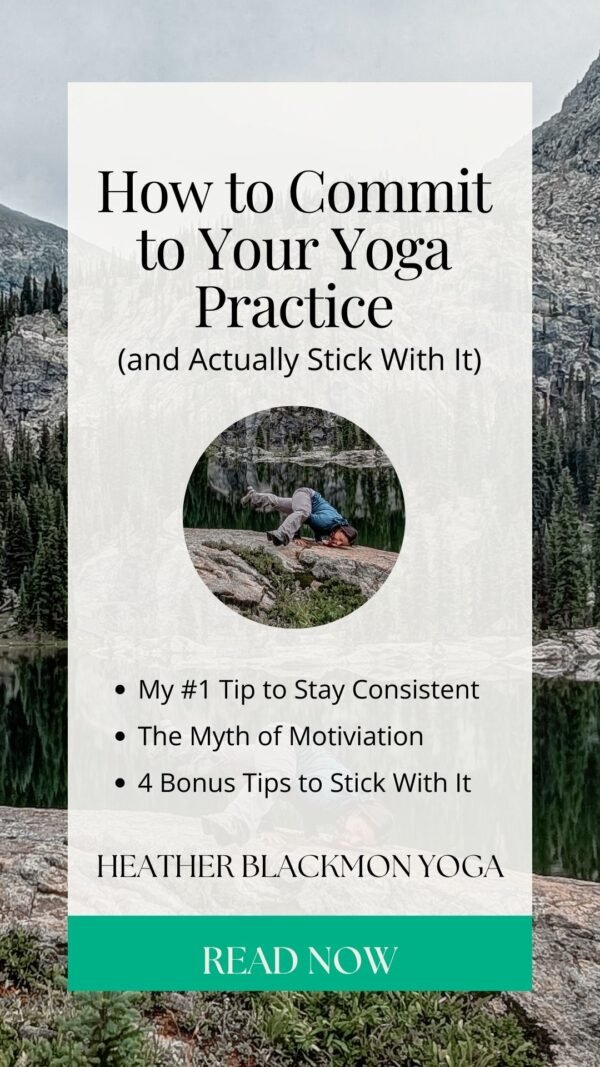When people hear that I am a yoga teacher, one of the most common response I hear is something link: Oh I love yoga, but I always run out of time and don’t get to practice very often.
Believe me, I get it! We are all so busy these days. For me, I run a consulting firm, teach yoga both online & locally, coach mountain biking for girls (in the summer), and teach snowboarding for adults (in the winter) — I know what it’s like to have an overflowing scheduled.
But, I’ve also had a consistent yoga practice for the last 5 years (at least). So what’s my secret?
Or said another way, what’s my top tip for committing to a yoga practice?
Most of us start with the best intentions, but then life gets busy, our motivation dips, or we’re just not sure what to do next on the mat.
My answer is simple, backed by both research and experience from coaching active people for almost two decades. And it’s the same approach I’m taking myself after coming back from a broken foot injury (which took me out of practice for 7 week): have a clear plan.

Why a Plan Matters More Than Motivation
Motivation is fickle. You feel fired up one week and completely drained the next. But you don’t need motivation to practice yoga (or any activity). You need a structured plan, that takes the guesswork out of practice, so you can just show up and move.
Research backs this up:
- A 2020 study published in Frontiers in Psychology found that people who had structured exercise plans were significantly more likely to stay consistent with their workouts compared to those who relied on motivation alone.
- Research from the National Institutes of Health also highlights that creating an action plan is one of the strongest predictors of exercise adherence and long-term habit formation.
That means instead of asking yourself, “Do I feel like practicing today?”, you simply follow the plan that’s already laid out for you. Less decision fatigue. More consistency.
What That Looks Like in Yoga
Your plan doesn’t have to be complicated. In fact, the simpler, the better. A few examples:
- Short Sessions: Even 10–20 minutes counts. Many of our members find that shorter classes are easier to stick with, especially on busy days.
- Practice Plans: While having any type of plan makes a huge difference, you’ll see more progress when you choose classes that focus on one area (like backbends, balance, inversions, or shoulders) for a set period of time (4–12 weeks). This is why we have practice plans inside the Outflow Studio, so you can pick your focus and follow the guide.
- Flexible Props: You don’t need fancy gear. Start with what you have at home — pillows for bolsters, books for blocks, and comfortable clothes you already own. I have a list of all my favorites in my free Ultimate Yoga Kickstart Kit to get you started.
More Ways to Stick With Yoga
Once you have your plan, here are a few more ways to stick with your practice from my Ultimate Yoga Kickstart Kit:
- Set up your space in advance: Create a home practice space that you enjoy. It doesn’t need to be big – just big enough to roll out your mat. Even better if you can stash your props nearby, so you have what you need without too much digging.
- Track your progress: Use a printable tracker or journal to record the days you practice. Sometimes seeing it on paper is the push you need to keep going.
- Pair yoga with another habit: For example, practice right after brushing your teeth in the morning or right after you get home from work. This habit-stacking technique makes it easier to stay consistent.
- Start with just one pose or a 10-minute flow: My freebies include short practices that make it easier to get on the mat, even when you’re busy. Most of my own practices at home are 10-30 minutes, which is why there are over 40 of this length ready for you in the Outflow Studio.
The key is to reduce friction and make it easy to show up, again and again.
My Own Practice Right Now
If you’ve been following along, you know I recently broke my foot (5th metatarsal, to be exact). For 7 long weeks, yoga was off-limits and I felt every bit of that stiffness and creakiness that comes from an active life without yoga. Thankfully, I was cleared to ride my indoor bike and continue strength training (with limitations) through this time.
But now that I’ve been cleared to return to my mat, I’m leaning on a plan just like I encourage my students to do. Having that structure helps me stay accountable, even while I rebuild my own practice step by step.
Ready to Commit?
Committing to your yoga practice doesn’t mean perfection. It means showing up consistently in a way that works for your body and your lifestyle. With a plan, you can finally build a practice that lasts — one that makes you feel stronger, more flexible, and more at ease in your daily life.
If you’re tired of starting and stopping your practice, put this advice into practice. Stop waiting to feel motivated or have more time. Build a plan that fits your life right now and stick with it.
And if you want the plan done-for-you, I would love to see you inside my Outflow Studio – where there are 8 structured practice plans waiting for you. They’re designed to fit into a busy, active life. Check out Outflow Studio here





